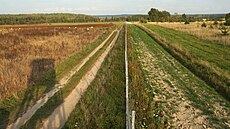Belarus–Lithuania border
| Belarus–Lithuania border | |
|---|---|
 Belarus–Lithuania border near Sakalinė | |
| Characteristics | |
| Entities | |
| Length | 679 kilometres (422 mi) |
| History | |
| Current shape | February 6, 1995 |
The Belarus–Lithuania border is an international border almost 679 km (422 mi)[1] in length between the Republic of Belarus (CIS member) and the Republic of Lithuania (EU member) and also serves as an outer border of the European Union and the western border of the Commonwealth of Independent States. The border is defined by the treaty of February 6, 1995 between the two countries. The ground demarcation of the border was completed in 2007.[2]
380 km (240 mi) of the border is on land, while 299 km (186 mi) are on water, crossing lakes, e.g. Lake Drūkšiai and following some rivers, e.g. Dysna River and Neman River. The border is based on the border between the Lithuanian Soviet Socialist Republic and Byelorussian Soviet Socialist Republic within the Soviet Union, which had remained largely stable since 1940.[3]
Since 2004 the border has served as the outer border of the European Union and, since 2007, the Schengen Area. These developments brought increased border controls and stricter visa requirements for crossing between the two countries. An agreement signed in 2010 aims to implement simplified traveling for people living within 50 km (31 mi) of the border.[4] As an outer border of EU, the border with Belarus has seen the most illegal attempts to cross the border in Lithuania, with 246 attempts in 2010.[5]
Definition of the border
The treaty defines the border as starting at the border tripoint of Lithuania, Latvia and Belarus, where there is a monument (55°40′50″N 26°37′48″E / 55.68056°N 26.63000°E). It goes southeast across Lake Drūkšiai, following river Apyvardė, across lakes Apvardai and Prūtas, further following Dysna River to the east, and further to Adutiškis railway station. It further goes north of Belarusian settlement Lyntupy, east of the Lithuanian settlement Šumskas, across the road Vilnius - Maladzyechna, goes around the area of Lithuanian settlement Dieveniškės from the east, south and west, goes to the North of Belarusian settlement Bieniakoni, crosses the road Vilnius-Lida and further follows Šalčia river. It further continues to the south of Lithuanian city Eišiškės, follows Načia river, goes to the south of Lithuanian settlement Dubičiai, reaches the source of Kotra River and further follows this river, then across lakes Grūda ir Dubas. It further crosses the railroad Vilnius-Grodno next to the stop Senovė, and the railroad to Druskininkai to the north of the stop Pariečė, continuing west towards Neman river and up against the current, and further following Mara river to the border tripoint of Belarus, Lithuania and Poland (53°57′22″N 23°30′54″E / 53.95611°N 23.51500°E).[6]
References
- ^ Kryptis, Dizaino. "Lietuvos Respublikos užsienio reikalų ministerija - Lietuvos Respublikos užsienio reikalų ministerija". Retrieved 1 September 2016.
- ^ "The World Factbook". Retrieved 1 September 2016.
- ^ Digrytė, Eglė. "Lithuanian-Belarusian border: Divided villages, divided lives". Retrieved 1 September 2016.
- ^ "R.Palaitis: "Iki bevizio režimo su Baltarusijos pasienio zona trūksta tik pasikeitimo notomiS"". Archived from the original on 13 December 2014. Retrieved 1 September 2016.
- ^ "Daugiausia pažeidėjų - ties siena su Baltarusija". Archived from the original on 22 December 2014. Retrieved 1 September 2016.
- ^ "Lietuvos Respublikos Seimas - Dokumento tekstas". Retrieved 1 September 2016.
